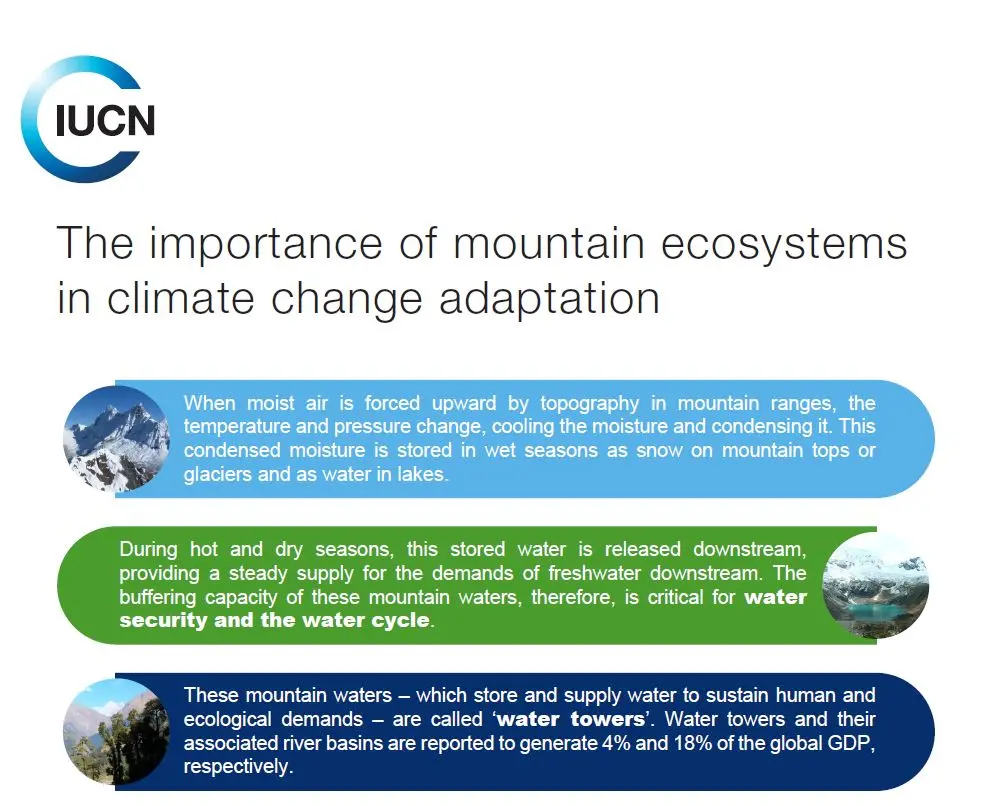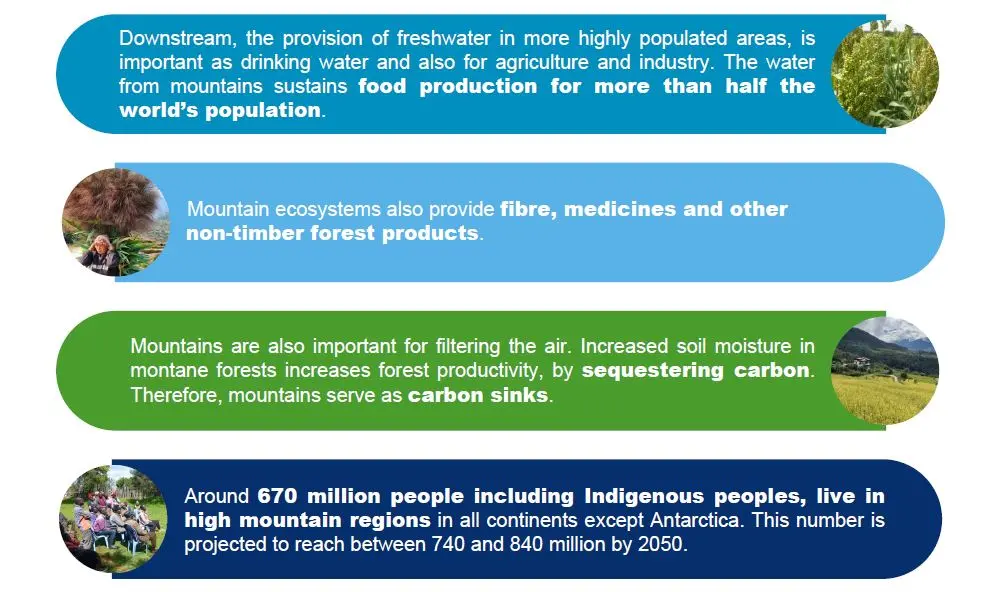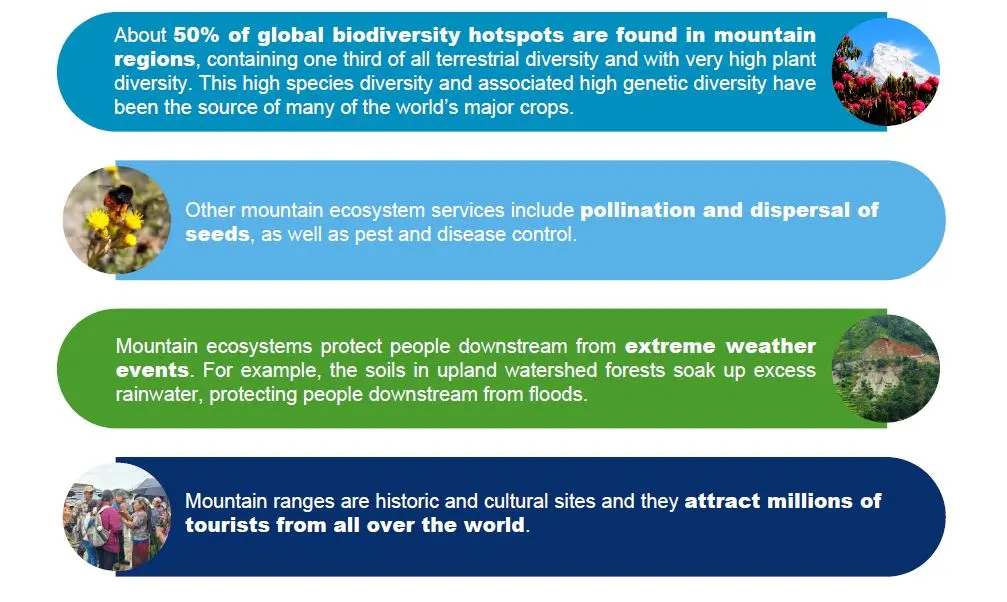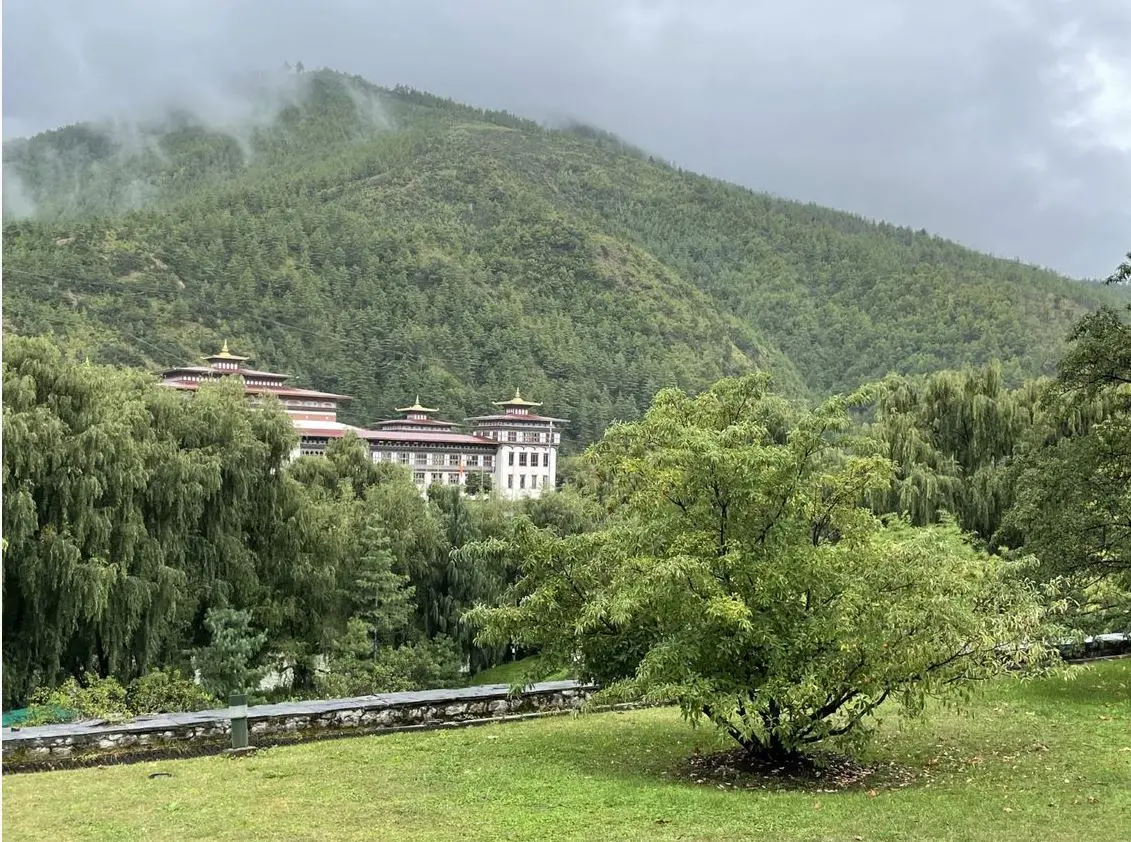- Mountains are also highly affected by climate change and, in the last century, compared to the global mean, they warmed faster than lower elevations.
- Warmer temperatures are resulting in profound ecological changes, destabilising mountain ecosystems.
- Increased temperatures in mountain regions decrease the amount of precipitation, causing snow and ice to melt earlier and accelerating the process of glacier retreat.
- At the same time, the patterns of precipitation (snow, hail, rain), as well as the pattern of loss of water from soil and plants are also changing. This means that the timing, quantity and quality of water supplied by mountains are changing.
- These changes have significantly affected mountain ecosystems, with changes in the distribution and abundance of species. As a consequence, some high mountain species are at risk from extinction.
- This, in turn, affects ecosystem functioning and the delivery of ecosystem services that are essential for human well-being described above.
Scaling Up Mountain EbA
Healthy mountain ecosystems help buffer the impacts of climate change for local communities, wildlife and downstream populations worldwide. Locally, mountain people rely on their surrounding environment for water, food, pasture and the raw materials upon which they build their livelihoods. Further downstream, towns and cities depend on mountain water for drinking, agriculture and industry.
Ecosystem-based Adaptation is widely recognized as an important strategy for adapting to the impacts of climate change. It is cost-effective, yields multiple benefits, and can be implemented by communities themselves. To help build support for EbA approaches in mountain ecosystems, both on the ground and in national and international policy, the project expanded EbA work started during the “Mountain EbA Flagship Programme” in the Himalayas (Nepal), Mount Elgon (Uganda) and the Andes (Peru) and supported the EbA approach being adopted in neighbouring Bhutan, Kenya and Colombia.
The Mountain EbA Program seeks to benefit local people directly, as well as the millions downstream who depend on the water and other benefits that come from mountains. The program also assists conservation and development projects already underway that could benefit from Mountain EbA practices. The EbA experience and data developed through this program will be instrumental to building wider support and generating financing for EbA within national governments and at international forums.
For more information on country-specific implementation measures please visit our project StoryMap.



Scaling Up Mountain EbA: Building evidence, replicating success, and informing policy
Building upon the success and achievements of the Mountain EbA Flagship Programme, the project, 'Scaling-up Mountain Ecosystem-based Adaptation: building evidence, replicating success, and informing policy' was implemented between 2017–2022. EbA actions included ensuring that the flagship project, as well as new projects, yielded long-term evidence and lessons; extracted knowledge and evidence; built local capacity to replicate successful approaches; and informed local, national, and international adaptation plans and policies, such as National Adaptation Plans.
Impacts in 3 Flagship Countries
In Perú 8,881 ha of Puna grasslands, in Nepal 6,774 ha of forest, and in Uganda 1,039.7 ha of riverbanks and farmlands respectively were restored or better managed through this project.
Nine EbA actions, three indicating long-term effectiveness (for ecosystem services) and sustainability are now implemented in the three flagship countries.
These include:
- The restoration of roadside vegetation in two project sites in Nepal to reduce erosion, through the planting of broom grass. When grown, the above-ground parts of this grass are cut and sold to make brooms and as fodder for livestock, economically and socially empowering participant families.
- The restoration of ancestral Yanacancha dams using both traditional knowledge and modern technologies to improve the water quality of springs in three of the four sites in Perú and the consequent community management of native pastures. Communities now obtain more milk yield and can sell livestock for a markedly increased price.
- The restoration of riverbanks and the introduction of agroforestry in farmlands in two micro-catchments in Uganda, to reduce the impacts of flooding. The grass on riverbanks and in farms provides fodder for livestock and on-farm agroforestry have yielded benefits of improved livelihoods and food security for families in project areas.
Impacts in 3 Expansion Countries
The project in Bhutan is supporting the Tarayana Foundation and the College of Natural Resources, Royal University of Bhutan by providing technical inputs to enhance their ongoing programme on springshed management, for two springsheds.
In Colombia, the project is i) collaborating with the GEF-funded project ‘Adaptation to Climate Impacts in Water Regulation and Supply for the Chingaza-Sumapaz-Guerrero Area’; ii) contributing to capacity building processes and the exchange of experiences: spaces for capacity building have been developed both at local and national levels; and iii) developing an e-learning course on EbA adapted to the Colombian context. Access to Módulo I, Módulo II, Módulo III and Módulo IV of the EbA e-learning course is now available.
In Kenya, the project has worked with an Indigenous community to carry out community-based vulnerability analysis, spatial mapping, feasibility analyses to identify suitable springs for protection and constructed infrastructure to protect a spring and ensure water security.
To learn more about the initiatives within our EbA projects in the 3 Flagship and 3 Extension Countries, visit our Country Briefs.
Impacts of Mountain EbA
In terms of mainstreaming EbA in the six countries, the mountain EbA approaches propounded by the project are now integrated into several national/sub-national plans/policies or strategies across the six countries.
The expected community outreach was 2,200 persons (50% women) for Perú; 600 (70% women) for Nepal; Woman carrying cut broom grass, Panchase, Nepal, 1,500 (55% women) for Uganda; and 500 Kenya. Perú has achieved an outreach of 1,676 (46% women); Nepal has surpassed the target with 2,200 persons; Uganda has 2,357 and Kenya 115.
At the global level, these EbA approaches have been mainstreamed and shared by global policy advocacy (such as through the Friends of EBA and the Global EbA Fund at various international fora) and will continue to be represented across global climate, biodiversity, and sustainable development frameworks.
In all countries, networks and synergies have been forged and established, so that the spread of EbA in the project countries is assured. The project’s three-pronged approach of working simultaneously with local communities, local government and national government has achieved the scaling-up impacts expected at the beginning. In several of the countries of the Scaling-up Project (for example, Bhutan, Colombia, Nepal and Peru) more projects have been funded by the Global EbA Fund, ensuring the continuity of EbA in mountains ecosystems and communities which are highly vulnerable to climate change.

Handbook System for the Design and Implementation of EbA
Looking to implement a Mountain EbA project but don’t know where to start? This handbook system was created to guide the process of designing, setting up, implementing, monitoring and up-scaling EbA interventions under the global Programme “Scaling Up Mountain Ecosystem-Based Adaptation: building evidence, replicating success, and informing policy”, supported by the Federal Ministry for Economic Affairs and Climate Action (BMWK), Germany, and jointly implemented by IUCN from 2021 to 2022 and The Mountain Institute from 2017 to 2019.
This handbook is based on the earlier publications Ecosystem-based Adaptation Handbook (Hernández, 2016), Making Ecosystem-based Adaptation Effective: A Framework for Defining Qualification Criteria and Quality Standards (FEBA, 2017) and Guidebook for Monitoring and Evaluating Ecosystem-based Adaptation Interventions (GIZ, UNEP-WCMC & FEBA, 2020). The contents of this handbook were applied by country teams of the Programme to take stock, generate learnings and replicate and consolidate what was implemented in the previous Flagship Programme (from 2012 to 2016), demonstrating its use is highly valuable at the out-set of projects. The utilization of the handbook system for implementation has been adapted into this publication with the aim to share these materials and methodology with the larger EbA community.
This document takes the EbA practitioner through the 7 stages of the EbA cycle, from selecting suitable sites for EbA interventions to supporting the process of mainstreaming EbA. Each stage is summarized and supported by resources and forms. The Forms help with recording information in a systematic manner, helping with decision making processes and ensuring consistency and comparability for particular aspects of EbA across interventions in different project sites. These Forms are best used at the starting point of any EbA project; however, they can be completed as the project advances.
Catalogue of Ecosystem-based Adaptation measures in mountains
Mountains are at the frontline of climate change, exacerbating existing vulnerabilities and socio-economic inequities for both mountain communities and those downstream. However, mountain communities have the capacity to adapt to these changes and mitigate the impacts of climate change. By utilizing the opportunities created by ecosystem services, mountain communities can build climate-resilience, resource security and consistent livelihoods.
This catalogue, organized by IUCN with the support of IKI and BMUK, presents and highlights the experiences using Nature-based Solutions (NbS) to build climate resilience in three mountain ranges: the Andes in South America, the Himalayas in Asia, and Mt. Elgon in East Africa. Its main objective is to provide practical information on these experiences to inform NbS practitioners, decision-makers, project designers and managers, researchers and local communities. The experiences illustrated within this publication include first-hand accounts and knowledge from project implementers as well as testimonies from local beneficiaries in the 3 flagship countries (Nepal, Peru and Uganda) and 3 expansion countries (Bhutan, Colombia and Kenya) to show the EbA measures that led to increased climate resilience, adaptive land management and secure water resources for these 6 mountain communities.



